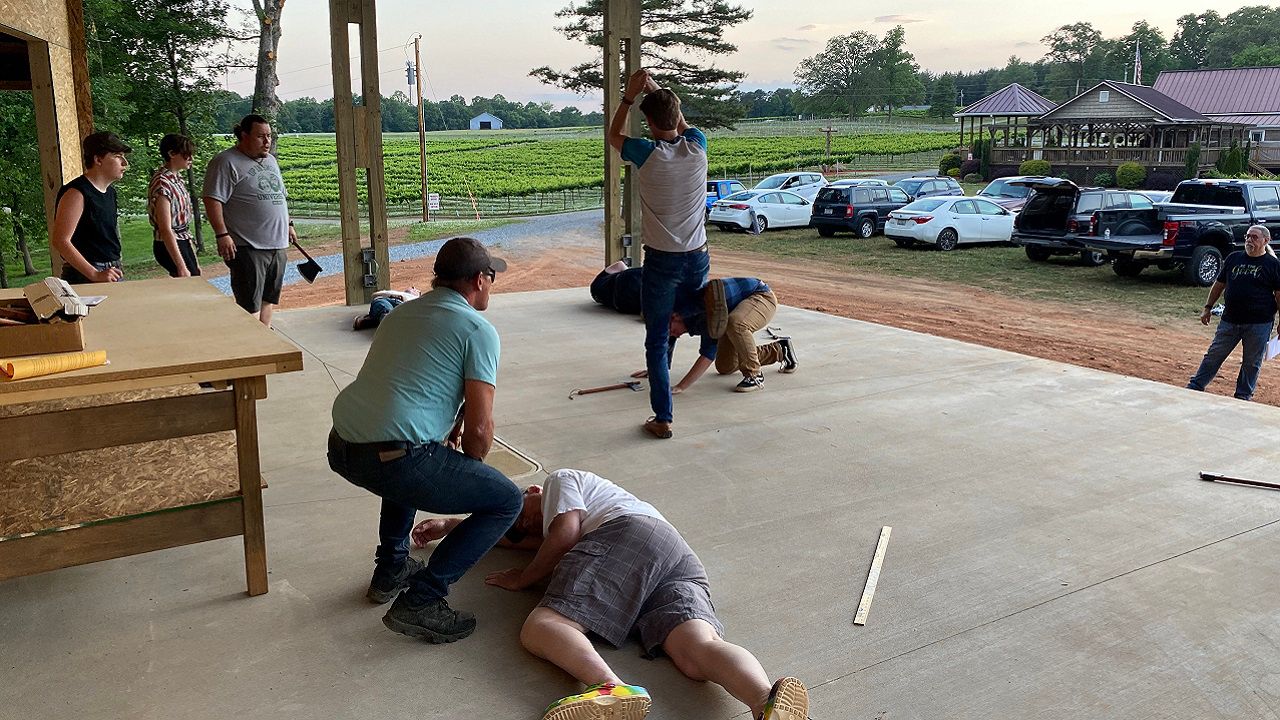CHAPEL HILL, N.C. — The big block letters and an abstract interactive jungle gym on the front lawn are quite inviting.
The Ackland Art Museum is on the University of North Carolina campus
The museum has more than 20,000 permanent works of art, along with regular rotating exhibits
The museum was founded in 1958 off profits made from the largest slave trading operation in American history
“We want to get you up on the terrace so that you’ll come on into the museum after you’ve had some fun,” Katie Ziglar said.
Ziglar is the director of the Ackland Art Museum on the UNC campus.
Ziglar said what you see outdoors is a visual sampler platter of the menu of arts inside the Ackland Museum.
As soon as you get indoors, a vivid projection depicting the pitfalls of life greets your feet.
“People can walk on it. It’s perfectly fine,” Ziglar said.
She pointed at all the themes captured in the projection.
“(I see) lots of spills and breaks. A mess I wouldn’t want to clean up. This is just unusual and fun,” Ziglar said.
Among the illustrations, fixtures, videos, photographs and sculptures, there is something for everyone.
“Oh my. Every day is different. Every day is just wonderful. You never know who is going to come and what you’re going to see. You learn something, too, every single day,” Ziglar said.“Oh my. Every day is different. Every day is just wonderful. You never know who is going to come and what you’re going to see. You learn something, too, every single day,” Ziglar said.
There are a variety of older and newer art mediums in use at any given time. Inspiration can strike at any moment — like it once did for Ziglar.
“I was in junior high school, and I went to Reynolda House museum in Winston-Salem where I grew up, and that was my first awakening to the power of museums,” Ziglar said.
The showrooms are a hidden gem on the UNC campus.
“I’ve always enjoyed it, and what I find is that a work of art is about so many different things,” she said.
Where no one gets the concept of bridging the community at large with the campus more than this UNC graduate.
“As you come through the front door of the museum and start through the lobby, you’re drawn back into the permanent collection galleries by the work of art that’s right in front of you," she said.
Dynamically placing bold concepts from rotating exhibits can also open the conversation for art what can be.
There is a special exhibit on display called "Good Object, Bad Object." A chair protrudes from a wall.
“(It) is supposed to wake you up to the idea that art can be, it doesn’t have to sit on the floor," she said.
The director said each work of art is like a time capsule of the region and culture it came from. Each piece tells a story right out of the pages of history.
“I love trying to puzzle all that out,” she said.
Which brings us to the museum’s history.
“Our founder, William Hayes Ackland, wanted to be interred in the museum,” she said.
Ackland is entombed in plain sight inside the museum. He stipulated upon his death in 1940 for his final resting place to be in a museum named after him. His legacy was entrusted to Duke University trustees.
When Ackland died, they didn’t honor his request to be buried inside a museum on the campus or in Durham. Instead, years of legal fights led to UNC officials winning the rights to his famed tomb and personal fortune. If you visit the art spectacle, you can see by the marble sarcophagus his wish came true.
Yet it’s the fortune used to build the museum, both the employees and the university must respect.
“It’s very, very important,” she said.
The Ackland trust was established with a nearly $1.5 million fortune accumulated during his lifetime.
The money from that trust was inherited by Ackland as a child.
The inheritance was created directly from the profits made by the first husband of Ackland’s mother, Isaac Franklin, as the founder of the largest slave trading operation in American history.
Signs hang on the walls, feet away from where Ackland is buried. The museum's policy is to be open about the past.
“It’s a way to heal from the past,” Ziglar said.“It’s a way to heal from the past,” Ziglar said.
She said they should never run from history.
“How it got to this museum is a big part of that story,” she said.
Learning where the past and present meet is why she loves their policy of free admission.
“We want no barriers to enjoying the Ackland Art Museum,” she said.
She said you shouldn’t have to be an artist to love exploring art.
“It should be encouraging to come to the museum to see the creativity of others, whether you have that gift or not yourself,” she said.
Whether you are an adult or child.
If you walk upstairs at the Ackland Museum, you enter a big space. The foyer is a college classroom. Students have the privilege of studying hand-selected art from the vaults.
Museum hours are Wednesday through Saturday 10 a.m. to 5 p.m. and 1 to 5 p.m. Sundays.
There are plenty of free and low-cost classes at the museum.








